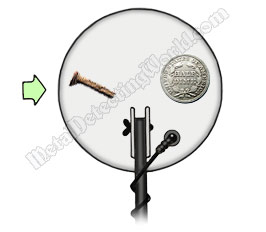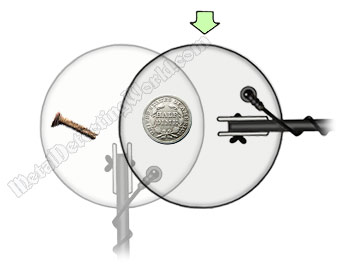Search Coils for Metal Detectors, page 18
Metal Detecting Techniques and Methods: How To Detect Masked Targets
Masked Targets Detecting Technique
When a target is detected, the time duration before the circuitry can respond to the next target is called "recovery time." If a detector's recovery time is set on a longer duration, this detector can be prone to ignoring targets lying in close proximity to targets that are rejected in accordance to the Discrimination setting.
Use of discrimination to reject iron nails only compounds the problem because ferrous objects lying in close proximity to a good target tend to cause the strongest masking effect and would not allow the positive audio to be heard. To avoid this problem in areas of concentrated iron junk, an ID metal detector should be used without any discrimination.
For example, if a rusted bottle cap is lying closely beside a coin, and the metal detector is set to reject bottle caps, the larger ferrous target can completely mask the response from the good target. Also a metal detector may produce a broken signal or none at all over a good target when an iron target precedes it in a sweep path.
Coin Masked by Iron Nail

By scanning the target area at 90 degrees or perpendicular to the initial direction of sweep, a good target can be encountered with less interference from rejected ferrous or nonferrous targets.

This is one of the reasons we come back to previously searched areas and continue to find more good targets. This is why it is important to come back to your favorite hunt sites and rework each of them at angles perpendicular and oblique to the original patterns of search.
The best advantage in a concentrated trash situation is to use a smallest 4-5" search coil which is able to "extract" good targets from the "trash blanket" and help you avoid scanning both good and junk targets simultaneously.